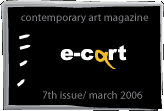Catalin
Gheorghe
The Periferic project - a social message
The Periferic project - a social message
Iasi is an universitary city, former industrial, with approximately
400 000 inhabitants. A small community follows with interest and consistency
the development of an event of contemporary art: the International Biennial
of Contemporary Art PERIFERIC.
Periphery is a theme decongestioned by the proliferation of the discussions
regarding the legitimacy of the cultural globalization policies - and
we are not to go into the details of the economic globalization - opposing
in a constructive way to the ideological claims of the centre to owning
the privilege of communication and circumscribed evaluation of the contemporary
art acts and production.
Without counting the exact histories, the PERIFERIC project, in its
classifiable sense of visual cultural event, manifested itself first
as an annual festival of performance, initiated by the artist Matei
Bejenaru who gathered around the first partner institution, the French
Cultural Centre, the most interesting performance artists in Romania,
and extending afterwards through an exhibition format based on the relationship
with the public and the artistic localization, first from the inside,
of the city.
Starting to be organized once every 2 years from the 5th edition, by
the Vector> Association, the PERIFERIC project was formally named
as a biennial, being thus exposed to any critic of this recipe. However,
in its development, this project negotiated its cultural location in
reference to the centers of significance and hierarchy that were trying
to attain visibility in order to acquire the best resources, from the
material to the critical ones.
The 6th edition of the project, which had as a curator the Swede Anders
Kreuger, was the first case of archaeological self-awareness of the
condition and situation of the city of Iasi, from its social structure
to the value of its alternative history and from its professional openness
to its affective complicity. Focused on the concept of the future, that
edition of PERIFERIC tried to speculate the image projection of a city
which urban dynamic would exercise through the collective effort to
reactivate the creative vitality and the strategic availability. Seen
as a "prophetic corner", a space which secrets confiscate
the certainties, the city of Iasi was re-orientating its rhetoric towards
a promise. The dislocation of cultural life through an art manifesto
was destabilizing the routine, compromising the conservative effort.
The public action was counting on the context's chronic reconsideration.
The mere "prophetic" de-conspiracy of the bended corner of
the map, made place for speculation on what was to follow. The evaluation
of the impact became directly proportional with the instigation to responsibility.
What was left to estimate was the reflexive correspondence between those
who played the role of curator, the artists, organizers, financing bodies,
partners and those who assumed the status of the public.
The investigations' extension from the limit of the prophetic corner
to the open scene of confirmations now resets a territory which administration
belongs to the correlation of the cultural policy to the stimulation
of social awareness. The concept of "focusing" aims at redistributing
the public opinion and invoking the cultural action.
The artistic act becoming instrumental from the perspective of offering
services, reinterpreting commercial products, exercising critical discourse
and generating knowledge helped reforming the understanding of art's
provocation as an active medium of integration into the practices of
daily life.
The 7th edition of the PERIFERIC project is "focused" on the
city of Iasi from the perspective of three distinct concepts, which
determine the field of action and relation in reference to the level
of expectancy and participation of both the specialized and the broad
public.
The concept proposed by Marius Babias and Angelika Nollert, "the
social process", emphasizes the modalities of configuration for
a motivation of political intervention upon the conventions of arts'
reception, through an ensemble of suggestive socio-cultural practices.
Art thus becomes an instrument for the activation of the process of
social alertness, instituting an alternative frame of communication
in view of regenerating the interest in debate and in activating the
abilities of investigation, argumentation and change.
In its turn, Florence Derieux proposes the concept of "strategies
of learning", starting from the premise of knowledge exchange aiming
at articulated understanding of a context. Coordinating import and export
of information, using specific strategies, can facilitate the flux of
cultural intentions, offering a lucid perspective upon the circumstances
of relativity and knowledge's modes of use. Relying on the idea of a
collective and collaborative memory which would determine considerably
the configuration of local contemporary cultural identity, under the
circumstances of the awareness of non-hierarchical circulation of information
and the inter-subjective exchange, one raises the problem of reconstitution,
rather than reconstruction, of the recent art history in Romania, understood
as the product of a social construction.
Last but not least, the title proposed by Attila Tordai, "Why children?",
opens the analysis on the social situation of abandoned children who
are the victims of history and of the update of administrative systems
in Romania. On the verge of European Union integration, the invention
of placements for abandoned children doesn't have its origin in the
local social imaginary but rather in the application of the European
structures' directives, without taking into account the real situation
of these children who are forced to live in isolated and artificial
environments.
The PERIFERIC project has a social message. Proposing public debates,
ideas exchanges, reactions and positions towards problematic situations
that have an impact on the daily life, images and processes of different
occurrences of individual or collective consciousness, this project
programmatically focuses on the need and the pleasure of acting on the
social through the artistic practice.
C?t?lin GHEORGHE is art critic and theorist,
co-editor of Vector> art and culture in context publication,
and collaborator of e-cart.ro.
Currently he teaches The Theory of Art Criticism seminars
at the University of Arts in Ia?i.
 |
|
|
||||||||||||||||||||
 |
 |
 |
|
|||||||||||||||||||
| |
|
|||||||||||||||||||||
 |
|
 |
|
|||||||||||||||||||
| |
|
|||||||||||||||||||||
 |
|
|||||||||||||||||||||
 |
 |
|
|
|||||||||||||||||||
 |
 |
 |
|
|||||||||||||||||||
| |
 |
|
|
|||||||||||||||||||
 |
|
|||||||||||||||||||||
 |
|
|||||||||||||||||||||
| |
|
|
|
|||||||||||||||||||
| |
|
|
|
 |
|
|||||||||||||||||
| |
|
|||||||||||||||||||||
| |
|
|||||||||||||||||||||
| |
|
|
||||||||||||||||||||
 |
|
|||||||||||||||||||||
 |
 |
 |
|
|||||||||||||||||||
| |
 |
|
|
|||||||||||||||||||
 |
|
|||||||||||||||||||||
 |
|
|||||||||||||||||||||
 |
|
|||||||||||||||||||||
| |
|
|
|
|
|
|
|
|
|
|
|
|
|
|
|
|
|
|
|
|
|
|